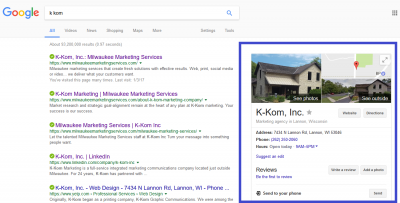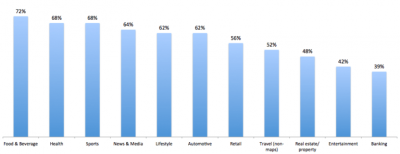Local Search Optimization and How Your Company Can Benefit
As a business owner in the digital world, optimization is very important. Local search optimization is not necessarily priority #1 for everyone, but if you’re looking to reach an audience located within a specific radius from you – eg. if you’re a service provider, going to people’s homes or businesses, or if you have a physical storefront – local optimization is exactly what you need to stay competitive in your market, especially if your known-competitors have already been doing this for the last few years. Google themselves confirmed that 50%+ of searches done on mobile are local, and that 60% of all searches are mobile, so that’s a huge percentage of local searches! Here are a few steps to get you where you want to be in your future customer’s search engine searches.
6 Steps Towards Local Search Optimization
Claim or set-up your Google My Business account
This is the listing (outlined in blue) that pops up at the top of mobile searches, and on the right side of search results on a desktop computer, along with a map, link to your website, business hours, reviews, etc. It’s very important that this is filled out with every possible detail, using location-based keywords, and is as accurate as possible, especially your NAP – name, address, phone number (keep these three elements consistent throughout the web!!).
You’ll also need to pick a business category that best fits you. You can choose multiple, but it’s better to pick one if possible. Lastly don’t forget great photos of your business, logo, products, employees, etc
This graph from Hitwise shows the share of online searches done on a mobile device, by industry:
Claim/set-up business listings on other major websites
- Yahoo! business listing, now called Aabaco Small Business
- Yelp for businesses
- Apple maps
- Facebook – they’re working to be a bigger influence in local search
- LinkedIn – for those who deal with other businesses, or business professionals
- Other social media sites depending on your unique customer base/target audience
- Any industry related sites you may be aware of
- A few such as the BBB (Better Business Bureau), local chamber of commerce or prominent local directories may not be free but offer potential customers a sense of trust when they see these.
Collect reviews and testimonials
These can be through your Google My Business, Yelp or even sites like Facebook. Address your bad reviews in a positive, assertive way, and let the good ones pour in. This creates another added trust factor for customers and Google itself.
Expand/add content with keywords to your website
Keyword research is necessary for this step, and ties in with your overall SEO strategy. Your Google category picked while setting up your Google My Business should be added to your list of keywords, often fitting for the homepage. Aim for 300 words per page, but ensure this content is valuable for your visitors. It’s helpful to include your target city or town as part of your keywords – category + city, like “marketing agency Milwaukee”.
Include your location on your website
It’s easiest to put this right into your header or footer so it shows on each page. If you have more than one location, have a separate page for each with the cities included (for SEO purposes)
Social Media
Build an audience in your local area. Grow a relationship with your current and potential customers. Find out exactly where these people are so you know where to focus your valuable time and effort.
This is just the beginning to getting your business on top of the local competition. If you have questions about local SEO services, or think you may be interested in local search engine optimization, contact K-Kom and we’ll be glad to answer your questions!
We also have printing services such as color brochure printing, menu printing for restaurants, and a variety of other options.








